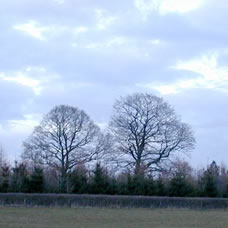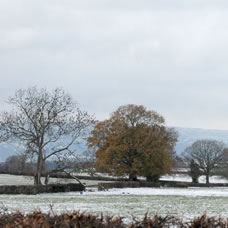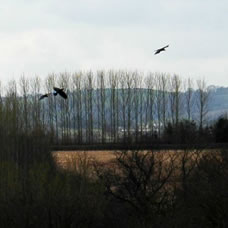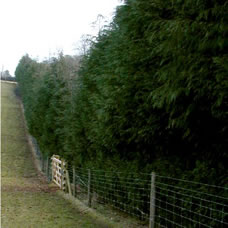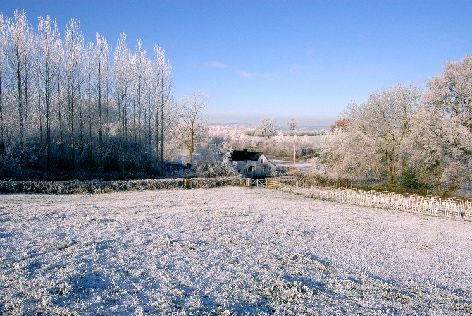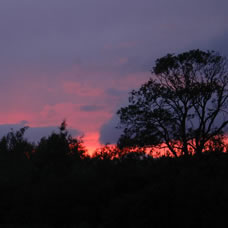Trees play an important role in pheasant shooting. Their planting and subsequent longevity have a permanent impact on the countryside and individual lives, sadly not always positive, and sometimes selfishly detrimental. Once you understand the way a pheasant shoot works and what people want from it – to fire at the unsustainable flight of a high moving target, then incongruous planting of thousands of trees makes sense.
Planting for a pheasant shoot is just that, a means to an end. It is not planting to improve or conserve the natural environment; trees are simply devices to facilitate and enhance the enjoyment of shooting, like a golf course and ball. Both make aiming and hitting, testing fun.
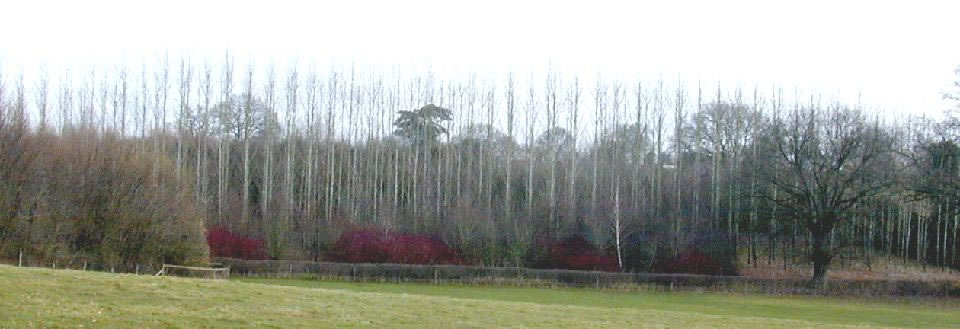
This veil of poplars is ten years old. Pheasants are forced to fly over tall trees to provide 'high' targets.
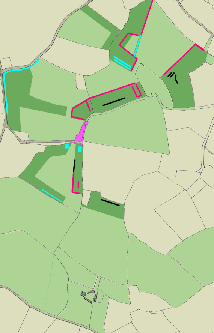
Dark green – tree-planting,
Turquoise – poplars, approx. 767.
Red – leylandii, approx. 1790.
Black – Scots pine approx. 170.
Trees are not temporary edifices wheeled on and off like stage props on the day of a shoot. They are static. Some are alien interlopers whose size, number, density and proximity deface the landscape. They also diminish and overshadow lives. Will the 21st century become renowned for blemishing cherished landscapes of fields, hedges and trees of previous centuries with utilitarian perpendicular lines and sombre walls?
Leylandii are "the fastest growing conifer in the British Isle"; the poplar is "a genus which includes some of the fastest growing of all trees" (1). This explains their prodigious planting here.
The planting of large quantities of trees known as afforestation(1) is currently covered by EU legislation, whether grant or privately funded. The Forestry Commission have to enter a proposal for new woodland planting on a public Register of New Planting and Felling.(2) But they have no legal obligation to inform neighbours as a County Council does with regard to buildings, roads and footpaths. Neither do landowners. If a neighbour is unaware of a proposed tree-planting scheme or the species, position and purpose of the trees, they will be unaware of their negative attributes until they become self-evident many years later.
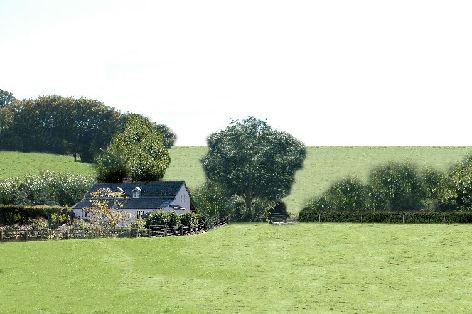
BEFORE This picture is a visual. It is the photograph on the right minus the trees that were planted for the shoot. If you doubt the veracity of this image, please refer to this old photograph taken before trees were planted for high pheasants.
Before the trees were planted the cottage was surrounded by pasture fields and meadow. It was light and sunny.
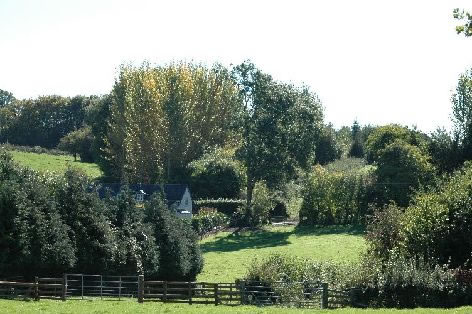
NOW
The trees planted in front and behind the cottage in this picture are only 12 years old. Can you imagine what it will feel like in 20, let alone 50 years? This picture was taken after some of the trees were felled.
- The Environmental Impact Assessment (Forestry) (England and Wales) Regulations 1999, http://www.forestry.gov.uk/england-eia
- Register of New Planting and Felling http://www.forestry.gov.uk/publicregister
If trees are planted and hedges are left to grow for high pheasants near a home, they may have a negative effect. This will include the loss of light and warmth, and even of views previously enjoyed by generations. Here, the bare branches of the poplars planted on the south(1) of the cottage obscure the warmth of the low winter sun's rays. They provide high pheasants for about 5 hours of shooting a year.
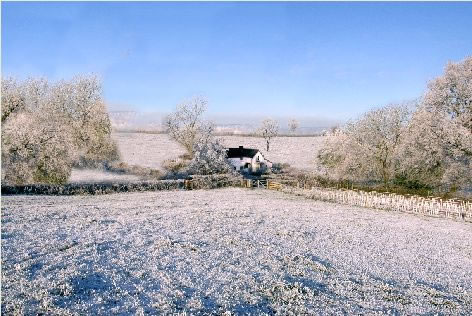
BEFORE This picture is a visual. It is the photograph on the right minus the trees that were planted for the shoot. If you doubt the veracity of this image, please refer to this old photograph.
Before I knew that pheasants were shot high in the sky, I thought these blocks of poplars were a planting mistake (the wrong bundle of sticks with roots) and would either be felled or have their tops cut off (they were still not too high). I could not think of any rational reason for planting trees with a potential height of 100 feet on the southern side of someone's home in the middle of the countryside.
- J.C. Loudon in his Arboretum et Fruticetum Britannicum, Vol III 27, 2nd edition, 1854 said of the poplar “but care must be taken to plant it at a sufficient distance; and, where shelter is wanted without shade, not to introduce it on the south side of any garden or orchard, unless at a distance of at least twice its ordinary height.”
The families who live in this home in the future will not experience the wonder of seeing the sunset.
Every year the band of intense colour gets narrower. I don't know how long it will be before it disappears behind the growing trees, but the thought of such a loss makes me very sad.
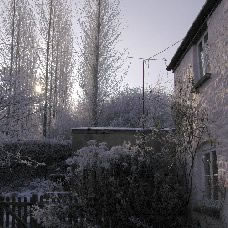
The sun at a given time of the day or year remains at the same height. Trees don't, they grow, casting cold shadows that get longer in time and size as each year passes.
Young trees, known as whips, cost between £0.58 (native majority) and £1.50 (a few).(1)
There are a variety of grant-funded schemes for planting trees. In the course of my research, I found evidence in the public domain to lead me to understand a substantial sum of money was paid by the Mark III Woodland Grant Scheme(2) for the 15,000 (approx) trees planted here for the pheasant shoot.
Why does the tax-payer subsidize a few hours of annual amusement for people who are willing to pay £35-£40(3) to shoot one pheasant?
As a nation we do not need pheasants to plant trees, but the shooting fraternity need trees to shoot pheasants. Is the British population being held to ransom?
Pheasant shooting happens principally in broadleaf or mixed woodland, rather than conifer forests. Broadleaf and mixed woodland accounts for around 3 million acres in Britain.(4) Of this, 2 million acres(5) is used by the 330,000(5) people who participate in driven lowland game shooting. I make that half a percent of the population shooting in two thirds of our countries broadleaf woods. I am glad I did not know that when I was a child. I grew up thinking woods were magical places, at school we played in them, we made dens in them and we climbed the trees in them. I am glad I did not know woods were places where grown-ups went to kill.
- Volume prices - tree nursery trade price lists are not generally available to the public.
- Mark III Woodland Grant Scheme http://data.gov.uk/dataset/woodland-grant-scheme-3
- Shooting Gazette, July 2012, page 51-52.
- National Inventory of Woodland and Trees. PDF Table 2, Page 10. http://www.forestry.gov.uk/pdf/nigreatbritain.pdf/$FILE/nigreatbritain.pdf
- PACEC Report PDF section 2.3 page 16 and section 4.2 page 57. Glossy brochure, page 7 and 11. http://www.shootingfacts.co.uk/pdf/pacecmainreport.pdf








